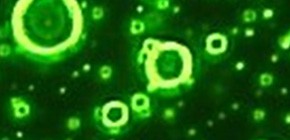
Success in constructing artificial cells with the capability to evolve
As part of JST Strategic Basic Research Programs, a group of researchers led by YOMO Tetsuya ( Professor, Graduate School of Information Science, Osaka University) succeeded in creating artificial cells having the capability to evolve, a feature of living organisms.
Recently the creation of artificial cells having artificially reconstructed functions of living organisms has attracted attention as a new technology. However, conventional artificial cells have no capability to evolve, a major feature of living organisms, so the scope of application has been limited. This group created artificial cells encapsulating artificial genomic RNA and few dozens proteins into cell-sized water-in-oil emulsions. In these artificial cells, genetic information was translated from genomic RNA, a replicative enzyme was synthesized, thereby, leading to replication of the original genomic RNA. Furthermore, this group succeeded in replicating the genome endlessly in the same manner as natural organisms do by artificially repeating fission and fusion with water-in-oil emulsion containing nutrients such as enzymes and amino acids necessary for protein synthesis. As a result of a long-term cultivation of these artificial cells, this group found that mutations accumulated in genomic RNA by replication error and more highly replicable genomic RNA evolved by natural selection. This means that artificial cells having a mechanism for evolution according to Darwinian principles were born.
The evolution of living organisms still hold many mysteries. One of the reasons is that it is difficult to directly observe evolution. Regarding the artificial cells produced by this group, their evolution can be directly observed in a test tube. Thus, their achievement is expected to help researchers to clarify the process of evolution. By evolving further many capabilities based on these artificial cells, this technology will contribute to the efficient production of food and drugs without depending on natural living creatures.
Abstract
The ability to evolve is a key characteristic that distinguishes living things from non-living chemical compounds. The construction of an evolvable cell-like system entirely from non-living molecules has been a major challenge. Here we construct an evolvable artificial cell model from an assembly of biochemical molecules. The artificial cell model contains artificial genomic RNA that replicates through the translation of its encoded RNA replicase. We perform a long-term (600-generation) replication experiment using this system, in which mutations are spontaneously introduced into the RNA by replication error, and highly replicable mutants dominate the population according to Darwinian principles. During evolution, the genomic RNA gradually reinforces its interaction with the translated replicase, thereby acquiring competitiveness against selfish (parasitic) RNAs. This study provides the first experimental evidence that replicating systems can be developed through Darwinian evolution in a cell-like compartment, even in the presence of parasitic replicators.

Figure 1
To learn more about this research, please read the full research report entitled " Darwinian evolution in a translation-coupled RNA replication system within a cell-like compartment " at this page of the Nature Communications website.
Related link

